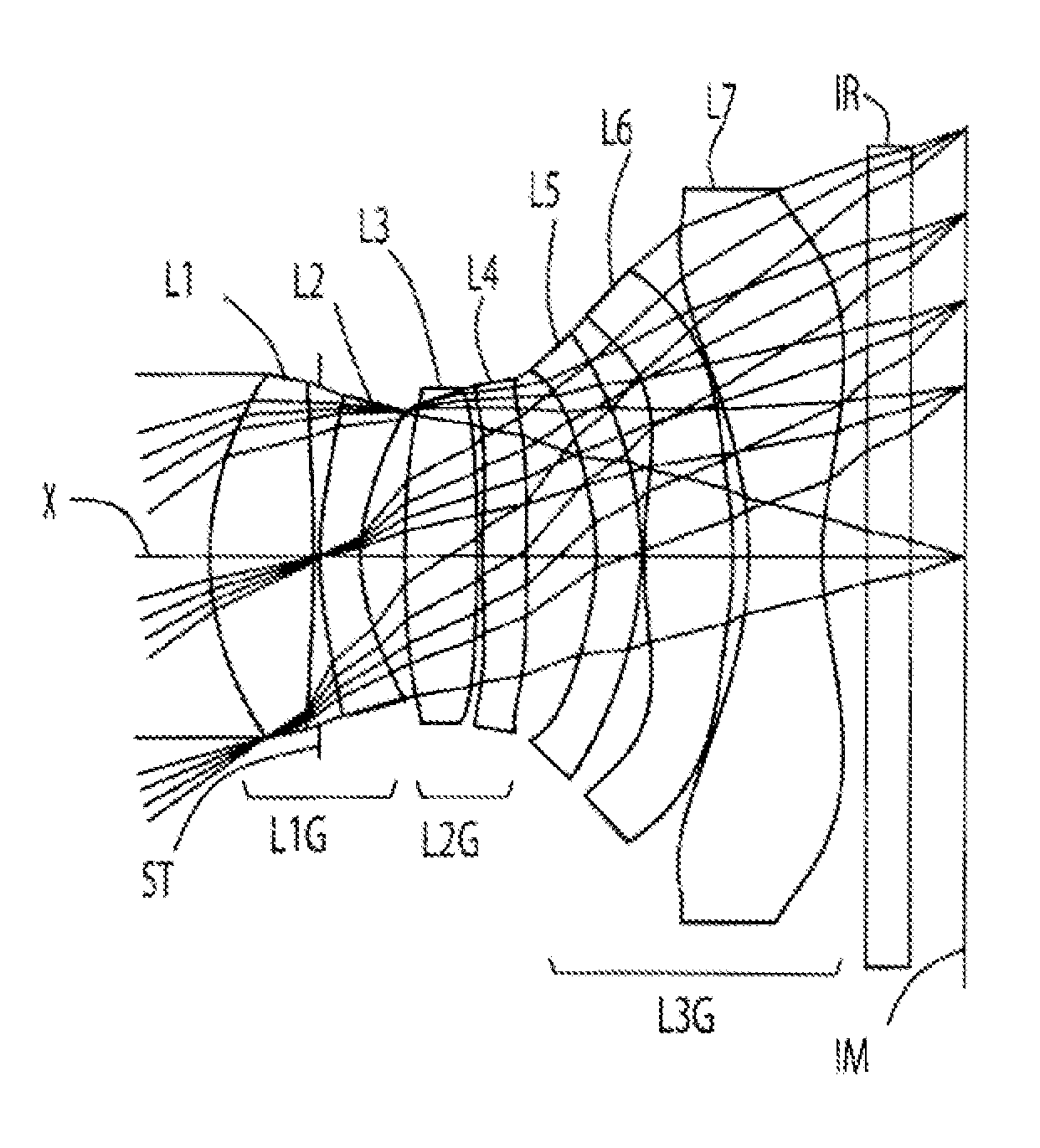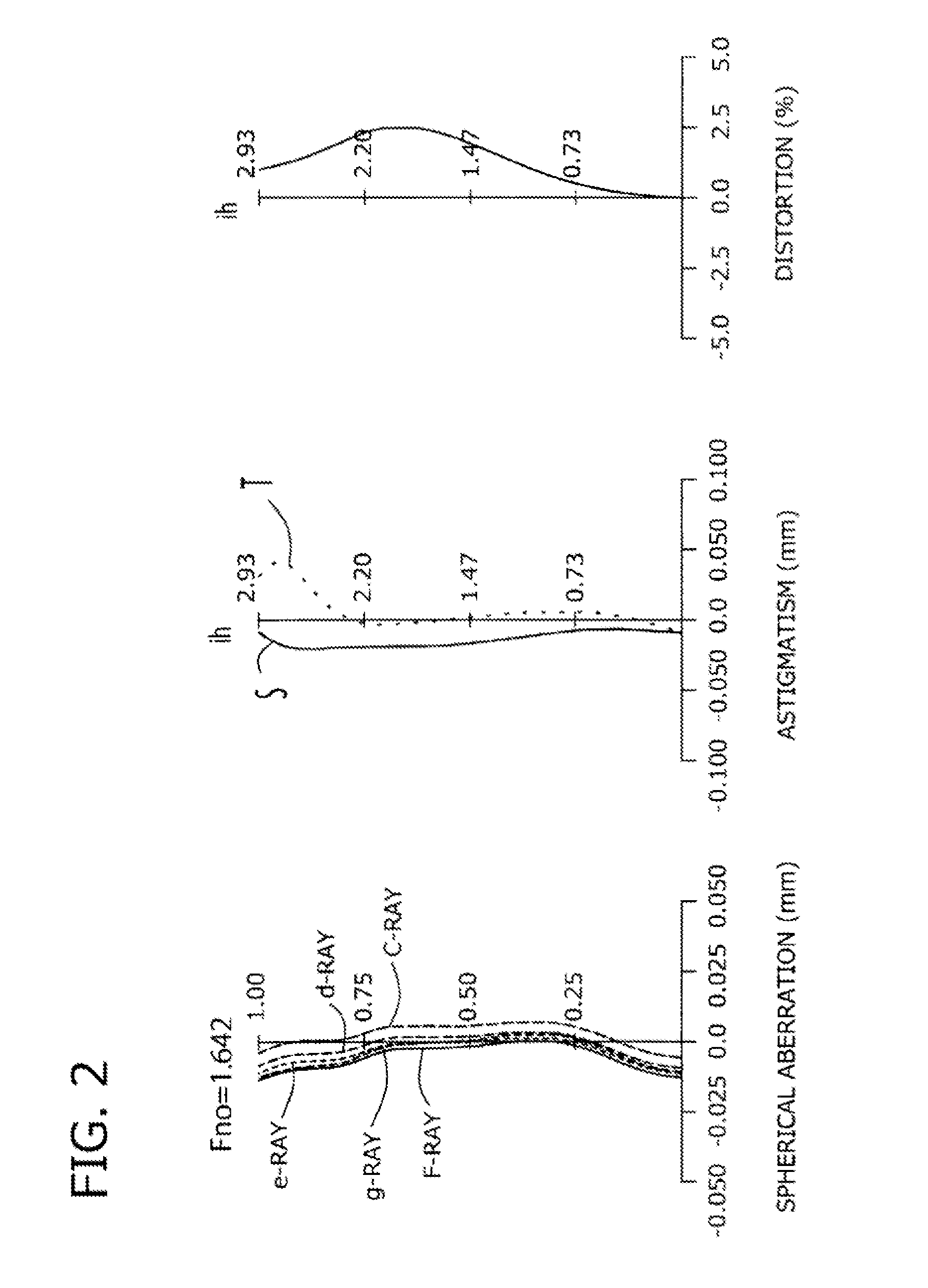Imaging lens
a technology of image pickup and lens, applied in the field of image pickup, can solve the problems of insufficient brightness, difficult to provide all the following features, and difficulty in applying it to an increasingly thin image pickup device, etc., and achieve the effects of improving brightness, reducing aberration, and reducing the number of lenses
- Summary
- Abstract
- Description
- Claims
- Application Information
AI Technical Summary
Benefits of technology
Problems solved by technology
Method used
Image
Examples
embodiment 1
[0125]The basic lens data of Embodiment 1 is shown below in Table 1.
TABLE 1Numerical Example 1in mmf = 4.06Fno = 1.64ω(deg) = 35.49ih = 2.934Surface DataCurvatureSurfaceRefractiveAbbe NumberSurface No. iRadius rDistance dIndex Ndvd(Objective Plane)InfinityInfinity 1*2.1200.7061.53556.16 2*−8.3880.045StopInfinity0.000 3*2.3280.2801.63523.91 4*1.2710.304 5*11.4990.4881.53556.16 5*−14.7780.040 7*7.1470.3001.53556.16 8*279.2330.479 9*−1.7240.3081.63523.9110*−2.4510.02511*3.2810.6031.53556.1612*−2.2760.10613*−2.7680.5001.53556.1614*1.9390.15015Infinity0.3001.51764.20Image PlaneInfinity0.517Aspheric Surface Data1st Surface2nd Surface3rd Surface4th Surface5th Surface6th Surface7th Surfacek−2.613E−010.000E+00−1.337E+01−3.683E+004.183E+010.000E+000.000E+00A43.254E−034.130E−02−9.523E−038.580E−046.036E−02−1.033E−02−9.734E−02A6−5.108E−04−1.584E−02−1.837E−021.710E−03−2.284E−02−1.354E−02−2.892E−02A8−3.395E−03−3.810E−032.118E−022.506E−022.337E−021.724E−023.955E−03A10−1.192E−034.403E−03−2.901E−03−2...
embodiment 2
[0128]The basic lens data of Embodiment 2 is shown below in Table 2.
TABLE 2Numerical Example 2in mmf = 4.05Fno = 1.64ω(deg) = 35.64ih = 2.934Surface DataCurvatureSurfaceRefractiveAbbe NumberSurface No. iRadius rDistance dIndex Ndvd(Object Plane)InfinityInfinityInfinity−0.28 1*2.22520.6871.53556.16 2*−7.4020.026 32.3500.2801.63523.91 4*1.3190.258 5*7.6910.4991.53556.16 6*38.6750.135 7*5.5970.3451.53556.16 8*−161.3340.393 9*−1.6710.3241.63523.9110*−2.3640.02511*3.2850.5971.53556.1612*−2.3810.09213*−3.2430.5001.53556.1614*1.7640.20015Infinity0.3001.51764.20Image PlaneInfinity0.491Aspheric Surface Data1st Surface2nd Surface3rd Surface4th Surface5th Surface6th Surface7th Surfacek−3.224E−010.000E+00−1.410E+01−3.794E+001.803E+010.000E+000.000E+00A43.360E−033.552E−02−9.091E−03−7.625E−035.314E−02−2.666E−02−1.118E−01A6−8.460E−03−1.679E−02−2.136E−02−7.935E−03−2.481E−02−1.773E−02−3.708E−02A84.952E−04−1.572E−032.404E−023.938E−023.264E−022.145E−02−8.888E−03A10−2.249E−031.713E−03−4.435E−03−3.624E−...
embodiment 3
[0131]The basic lens data of Embodiment 3 is shown below in Table 3.
TABLE 3Numerical Example 3in mmf = 4.07Fno = 1.64ω(deg) = 35.49ih = 2.934Surface DataCurvatureSurfaceRefractiveAbbe NumberSurface No. iRadius rDistance dIndex Ndvd(Object Plane)InfinityInfinity 1*2.27440.6841.53556.16 2*−7.1580.045StopInfinity0.000 3*2.1240.2801.63523.91 4*1.2020.290 5*12.6790.5391.53556.16 6*−3.6430.030 7*21.2130.3001.53556.16 8*9.1100.520 9*−1.7470.3001.63523.9110*−2.4760.02511*3.1080.5721.53556.1612*−2.4430.11813*−2.5820.5001.53556.1614*2.0980.15015Infinity0.3001.51764.20Image PlaneInfinity0.495Aspheric Surface Data1st Surface2nd Surface3rd Surface4th Surface5th Surface6th Surface7th Surfacek−2.650E−010.000E+00−1.004E+01−3.488E+009.900E+010.000E+000.000E+00A42.045E−035.656E−02−1.778E−02−5.991E−036.906E−021.077E−03−1.121E−01A62.534E−03−3.317E−02−3.146E−02−1.073E−02−2.159E−02−8.057E−03−4.663E−02A8−6.022E−033.803E−032.480E−021.748E−023.366E−02−1.037E−021.618E−02A106.657E−051.036E−02−1.311E−02−3.230E...
PUM
 Login to View More
Login to View More Abstract
Description
Claims
Application Information
 Login to View More
Login to View More - R&D
- Intellectual Property
- Life Sciences
- Materials
- Tech Scout
- Unparalleled Data Quality
- Higher Quality Content
- 60% Fewer Hallucinations
Browse by: Latest US Patents, China's latest patents, Technical Efficacy Thesaurus, Application Domain, Technology Topic, Popular Technical Reports.
© 2025 PatSnap. All rights reserved.Legal|Privacy policy|Modern Slavery Act Transparency Statement|Sitemap|About US| Contact US: help@patsnap.com



